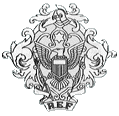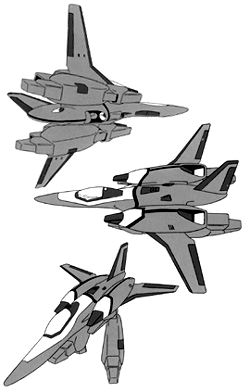

Designation:SVR-1 Voyeur
|

|
||||

|
|||||


WARNING: DRAFT Material!

| Flight Length: | 16.1 m |
| VTOL Length: | 15.5 m |
| Flight Height: | 5.1 m |
| VTOL Height: | 8.9 m |
| Max. Wingspan: | 9.5 m |
| Min. Wingspan: | 6.2 m |
| Total Dry Weight: | 13.6 metric tons |
The skin of the Voyeur and Vixen is composed of an advanced titanium-steel alloy. The skin stops all small arms and heavy infantry weapons fire, provides good resistance to light mecha-mounted weaponry, such as the Zentraedi 22.3mm HE autocannon round, and poor resistance to medium mecha-mounted weaponry, such as the Valkyrie's 55mm APFSDS round.
The wing, hull and tailplane leading edges are covered with a special heat resistant ceramic tile to protect the plane against the high temperatures associated with high Mach numbers in an atmosphere. However, the armor protection these tiles provide is minimal.
The Voyeur and Vixen provide full protection from nuclear, biological, and chemical hazards, using an overpressure cockpit environment activated by radiation and hazardous chemical sensors, or manually when biological warfare conditions are anticipated. The internal consumables supplies can provide atmosphere for two days maximum in the single seat version, one day maximum in the double seat version.
The Voyeur and the Vixen are two versions of the same aircraft. Originally, the Voyeur was developed as a reconnaissance system relying on speed and a stand-off radar and camera system to collect its information and retire to its base. The design requirement was caught up in the anti-Veritech backlash that coursed through the Earth Government in the mid 2010s. As a consequence, the Voyeur was never designed with a Battloid or full Guardian form, leaving only the legs for use in VTOL landings.
The Voyeur was a well-streamlined plane with a single tailplane and two aft-mounted, cranked wings. The whole wing assemblage could swivel forwards, increasing the wingspan and low-speed characteristics. Two fusion turbines were mounted in the legs, and two more powerful ramjets were placed in pods above the legs, alongside the fuselage. Although these could not be used below Mach 0.75, the Voyeur had a flight profile which gave the plane most of its flying time at high Mach speeds. The lack of any internal armaments and the largely non-Veritech design freed up a lot of room for additional reaction mass stowage, and the Voyeur enjoyed a large delta-v capacity in space. The reconnaissance equipment was based on the standard avionics of the Alpha fighter, augmented with high-resolution long range sensors and interpretation systems, and so effective that it was copied in the VF-6R version of the Alpha fighter.
The SVR-1 Voyeur was employed in a flight of six on all ships from light cruisers up, and remained in service until the VF-6R, and the VE-12, which together formed the Elint Legioss, replaced them. At that time, only three had been destroyed by enemy forces, despite usage of the plane in nearly all theaters in which the REF fought.
The SVT-1, a two-person version that sacrificed the lower fuselage Elint bay in favor of more reaction mass tankage, was also procured as an operational trainer. However, the Vixen, as this mecha came to be known, outlasted the Voyeur by decades in operational service; because of its speed and additional seat, the Vixen was an excellent high-speed courier and VIP transport plane. In addition, many of the higher-ranking flight-qualified officers took to upholding their flight hours (to keep their pilots' wings and the additional pay that went with them) in the Vixen, which had excellent handling, a large range in space, and a reputation as the 'hottest ride' available in the REF. But most importantly for the lower echelon combat pilots was its use as a pick-up plane for downed pilots behind enemy lines: with its high speed, excellent sensors, large tankage and extra seat, the Vixen could infiltrate hostile airspace, locate a downed pilot, extricate him or her and ascend to orbit or just dash to safety faster than any other plane or mecha in the REF. The Vixen remained in service with the REF, again in six ship elements on capital ships, until long after the Reflex Point operation, and decommissioned planes were extremely popular in the private aircraft market, so much so that several private firms offered "kit plane" versions of this aircraft starting in the 2060s.
Return to REF Index
Return to the Robotech Reference Guide Home Page.
Robotech (R) is the property of Harmony Gold. This document is in no way intended to infringe upon their rights.
Content by Peter Walker